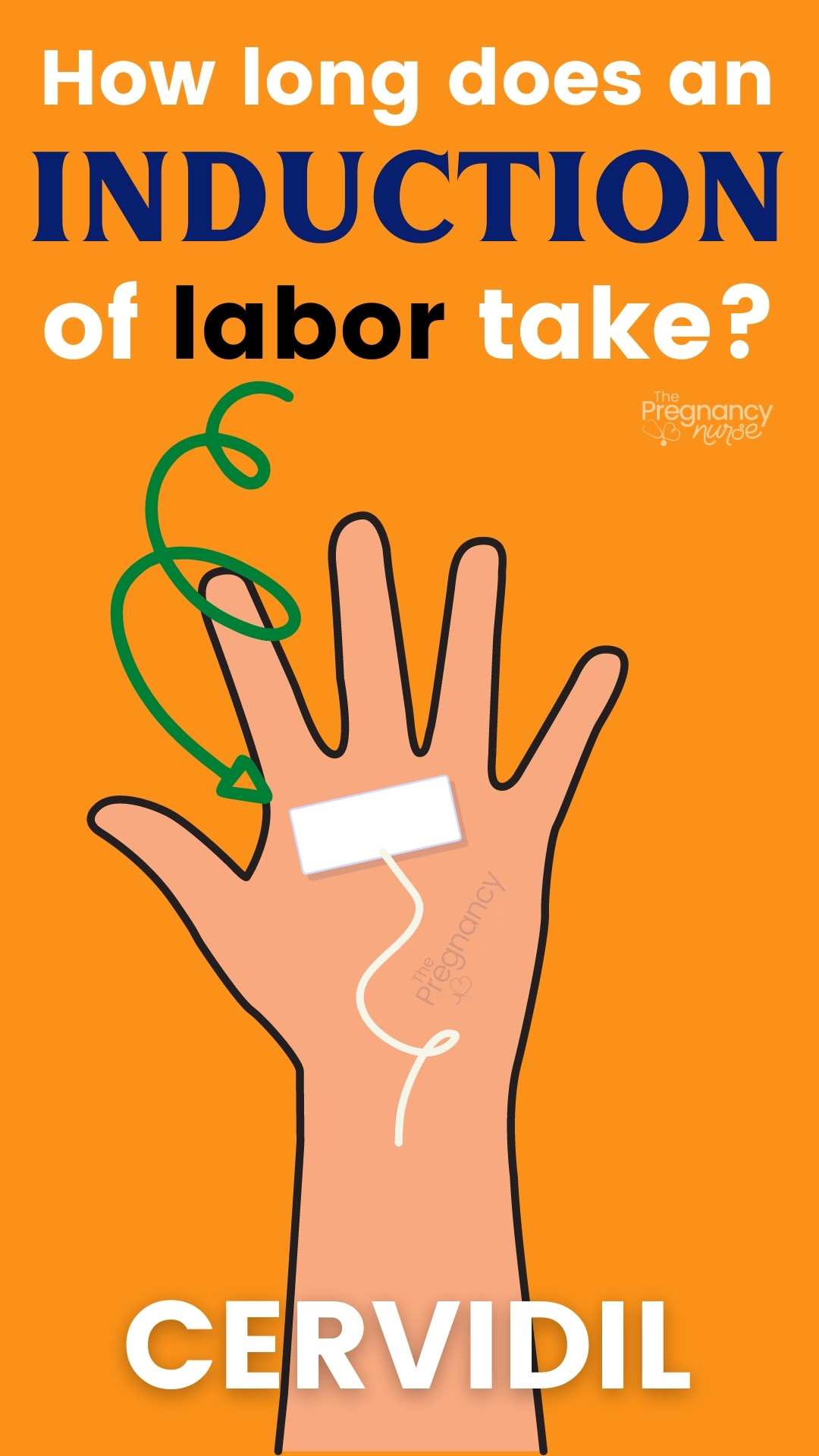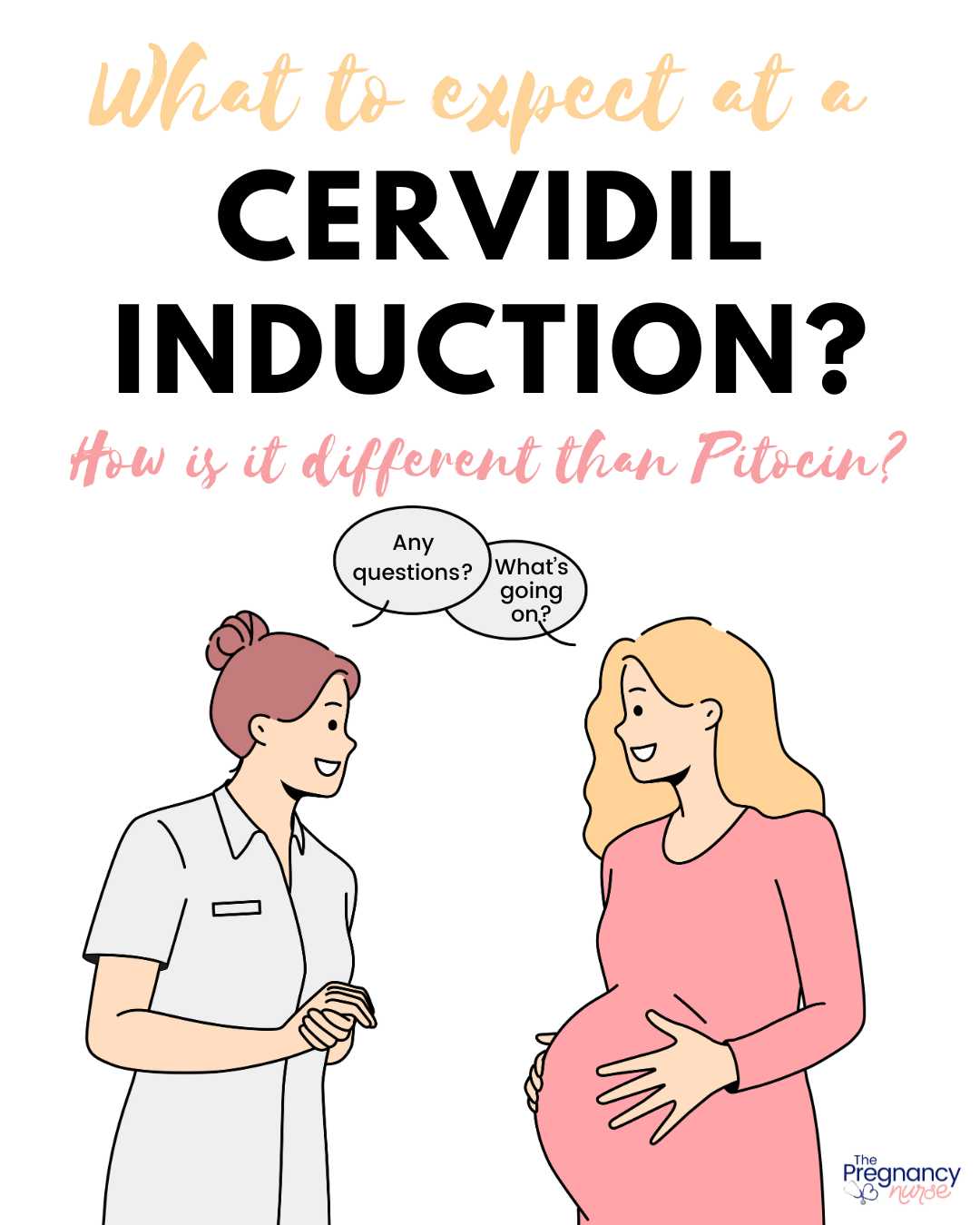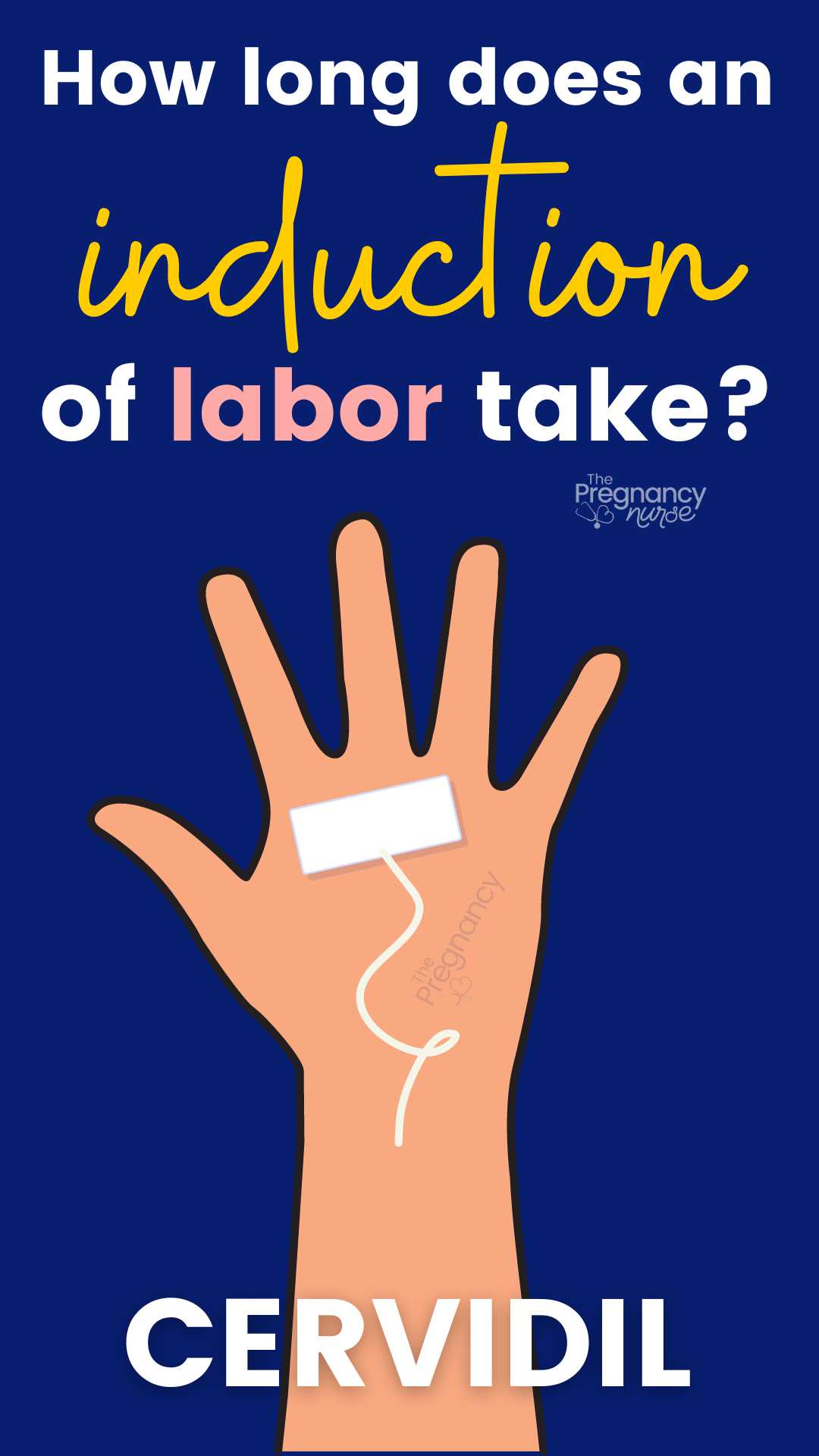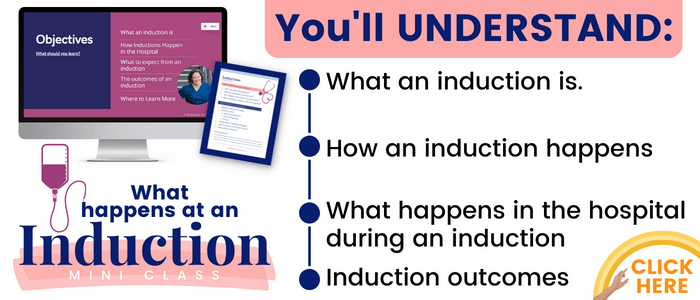👋 I’m so glad YOU are here. Are you looking to also get your partner prepared? This is for BOTH of you. Couples just love it and I know you want to both feel prepared!
Your labor induction could happen with Cervidil. It’s a vaginal insert that includes hormones to start your induction of labor. How long does Cervidil take to induce labor and what should you expect during your Cervidil induction?
Hi, I’m Hilary — The Pregnancy Nurse 👩⚕️. I have been a nurse since 1997 and I have 20 years of OB nursing experience, I am also the curly head behind Pulling Curls and The Online Prenatal Class for Couples. 🩺 I have used Cervidil hundreds of times and have helped thousands of moms through an induction. I can give you some clear ideas about what to expect with a Cervidil induction.
Before we get going though, inductions require some special questions of your provider — grab them here:
What is Cervidil?
Cervidil® is a cervical ripening agent used to start the induction process. It is most often used when your cervix is unfavorable for labor.
The cervidil insert is about 2 inches long and about ½ an inch wide (like the photo above). It has some firmness, but will become more flexible when hydrated.
It is placed vaginally in pregnant women by delivery care providers for a 12-hour period and then usually the following morning it is removed. Cervidil should only be inserted vaginally, it does not come in a pill or IV form. It does remain in place for 12 hours following insertion (unless you have a poor reaction to it).
The Cervidil insert normally has 10 mg Dinoprostone which is a synthetic hormone used to get labor going. It is one of the induction methods recommended by the American College of Obstetricians.
The aim of Cervidil induction is to increase your chances of a vaginal birth through starting contractions.
Cervidil is only given in the hospital setting (not in birth centers,. and should not be used during a home birth) as it does increase your risk. Sometimes it is given by your doctor or midwife. In many places the nurse inserts it.
When is Cervidil Used
Cervidil is used for an induction of labor. Most often inductions are for medical reasons. Reasons (most often pregnancy complications) can include:
- Past your due date
- High blood pressure
- Preeclampsia
- Too little or too much fluid in the amniotic sac
- Gestational diabetes
- Other types of diabetes mellitus
It can also be used with an elective induction, where you make the choice to be induced at the end of pregnancy.
The idea is to decrease the amount of time that you are in labor, and studies do show that that CERVIDIL significantly reduced your time to delivery (when compared with a placebo). The labor time was more significantly shortened in women who had already had a baby vs first time mothers.
Cervidil is usually given to soften and thin-out your cervix. We’re hoping that it will help you dilate to about 3 cm before we start Pitocin (more on that coming up).
When Cervidil is Not Used
There are times when the use of Cervidil is contraindicated. Some of those times are (this is not an exhaustive list)
- Previous cesarean section or other uterine surgery
- Medical conditions like if the patient is very sensitive to prostaglandins
- Unexplained vaginal bleeding
- If they think the baby is too big
- Baby’s heart rate has issues (as shown on fetal monitoring)
- Placenta previa
- Active genital herpes infection (those babies have better outcomes through a cesarean section)
Inductions can be tricky. You really need to make the choice to be induced (not feel forced into it by your provider). I love this induction mini class. It not only explains how inductions work, but it also gives you the words to use with your provider to make the choice if induction is right for you.
If you’re feeling forced into an induction listen to this podcast episode with one of my favorite providers. We talk about how we make the choice on how to advise, you and what you can do with that info! You should keep asking questions of your healthcare professional until you feel like you can make the right choice for you. You can also listen to it right here:
How does Cervidil Work
Cervidil is used in a medication induction to start uterine contractions.
The idea (as with any induction process) is to make you contract, and advance the baby into the birth canal.
Most often Cervidil placement is followed by a Pitocin induction as Cervidil most often just softens your cervix and hopefully gets you to about 4 cm. After 12 hours Cervidil is removed and most providers order Pitocin after that. Pitocin is the synthetic version of Oxytocin.
Sometimes Cervidil causes contractions so much that your water breaks. at that point, they may remove the Cervidil (or it may be washed out). Most providers don’t do Cervidil with a ruptured bag of waters (my understanding is that it will wash out the hormones and won’t work as effectively).
If at any point there is fetal distress (the heart rate has problems on the monitor) or uterine hyperstimulation (having too many contractions too close together) they make remove the insert and perform other medical interventions as needed. This is normal for any induction process.
Pro Tip: In an induction you are more likely to consider something for the pain. Grab my pain management options right here:
How Long Long After You Take Cervidil Will You Have Your Baby?
In the studies of those using Cervidil, first time moms took around 25 hours (average is 34-37 with no Cervidil), and in pateints who’d already had a baby it took 12-20 hours (average was 24-27 hours with out Cervidil)
Find the study here: https://www.cervidil.com/hcp/efficacy/
Beyond that study, it really depends on what your cervix is when they place it. If you’re already 2 cm, vs someone who’s cervix is closed it does change thing. The hospital will quantify how ready your cervix through the bishop score (I talk about that in this class).
A nasty fact about Cervidil is that it’s effectiveness is often based on how well it is placed. That means you need to attempt to tolerate the placement as well as possible (I have a post on painful exams that might help) and tell your provider you really want a good placement and are ready for them to do that.
And, if you like pro tips like that one, definitely join me in here.
Complications of Cervidil
As with any medication, there are potential risks with cervidil.
Studies show there can be a risk of postpartum bleeding due to disseminated intravascular coagulation (meaning your platelets are busy stopping other bleeding and there isn’t enough for them to stop the hemorrhage) — especially in women over 30.
Cervidil has been shown to be associated with an increased risk of:
- Uterine rupture
- Need for an emergency c-section in the operating room
- Risk for infection (as something is placed in your vagina)
- Abdominal pain (I mean…. you want contractions, so I’m not sure on this one)
In rare cases you are given Cervidil and it makes your uterus contract a TON (called tachysystole) which is not good for you or for the baby (because it decreases their oxygen supply when the uterus contracts). In that case the nurse would remove the Cervidil and could possibly give you a medication to stop the contractions (similar to what you’d get in preterm labor). If the baby wasn’t doing well (as told on fetal monitors), you would have a cesarean delivery. That is super rare though, I’ve never seen it.
As in all cases of labor, there is a chance of amniotic fluid embolism (although it’s not particularly increased in Cervidil) and as we are placing a foreign body into your body, there is a risk of infection.
It sounds like labor will be soon for you — grab my hospital bag packing list):
Cervidil Side Effects
The most common side effects of Cervidil (as shown in clinical studies) are
- contractions that are more frequent
- changes in the baby’s heart rate baseline/pattern
- nausea, stomach pain
- feeling of warmth in the vaginal area
- back pain
And, as with any other use of medications you could have signs of an allergic reaction. Things like hives; difficulty breathing; swelling of your face, lips, tongue, or throat.
The good news is with Cervidil we can pull it out if there are complications (vs Misoprostil, once it’s given it can’t be “taken back” — but we do have medications to reverse it’s effects).
Other Options for Induction
There are different ways to go into labor.
Most of the cervical ripening agents (like the use of misoprostil) have very similar things that could be side effects or complications. They do have different medications that they use, so you could try a differen type of medication if you were very sensitive to Cervidil.
You can also try a manual method like a…
Foley Catheter
They place the balloon of the foley catheter into your cervix and expand it (with water). That pushes on the edge of your cervix to open it.
You could also wait for natural labor spontaneous labor. It is important to weigh the risks of waiting vs the benefit of getting the baby out.
Before your provider schedules an induction, they SHOULD talk about the risks, benefits and alternatives of the procedure. If they don’t, you can always ask to hear about those things. It’s their job to share it.
Remember that while a successful vaginal delivery may be a large goal of yours, a healthy mom and baby is the most important thing — so be sure to talk with your providers about what you should do or expect at your induction.
Cervidil vs Pitocin
Most often pitocin is given once you are past 3 cm of cervical dilation.
Cervidil is given to soften and slowly open that cervix, and pitocin is there to start the more active labor contractions.
Here are a few differences:
- Pitocin is given via IV, but Cervidil is placed virginally
- Pitocin is more exact since it is given IV, and Cervidil’s effectiveness somewhat depends on the placement (and experience of the person placing it).
- Pitocin is a bit more “high risk” that Cervidil and can cause harder contractions with more complications
- Due to its high risk nature, patients on pitocin need to be monitored continuously, but those on Cervidil may be able to be off the monitor for longer periods (depending on your hospital’s policies).
Ok, this was just a BRIEF overview of inductions — but I really want you to understand how your induction works with ALL of labor. The Online Prenatal Class for Couples truly is the easy way to get prepared for birth. I know you want to feel prepared, so come join me!
Or, if you JUST want the info on inductions — grab my class Inductions Made Easy (fyi, that class is included in the Bump to Bassinet Bundle).











 What is Stripping Membranes? (Membrane Sweep)
What is Stripping Membranes? (Membrane Sweep)

That is a good tip particularly to those fresh to the blogosphere. Short but very accurate information… Appreciate your sharing this one. A must read post!
I experienced tachysystole within 45 minutes of receiving cervidil. My contractions were 90s long with maybe – 30s break in between. The contractions also hit at max level with no ramp-up, so the CTG showed my contractions as essentially box shaped—hitting the top line each time. My mom mentioned this to the nurse, and I was still told she wouldn’t check me until the 12 hour mark. The cervidil remained in until my water broke, 5hrs and 40mins later. Proper medical procedure was clearly not followed. My daughter was then born 20 mins after that, after I went from 5cm to 10cm in about 10mins.
Sounds less than fun — but it was meant to start contractions. Would you have preferred they remove the Cervidil? That’s an option, but not a lot of patients ask for it.